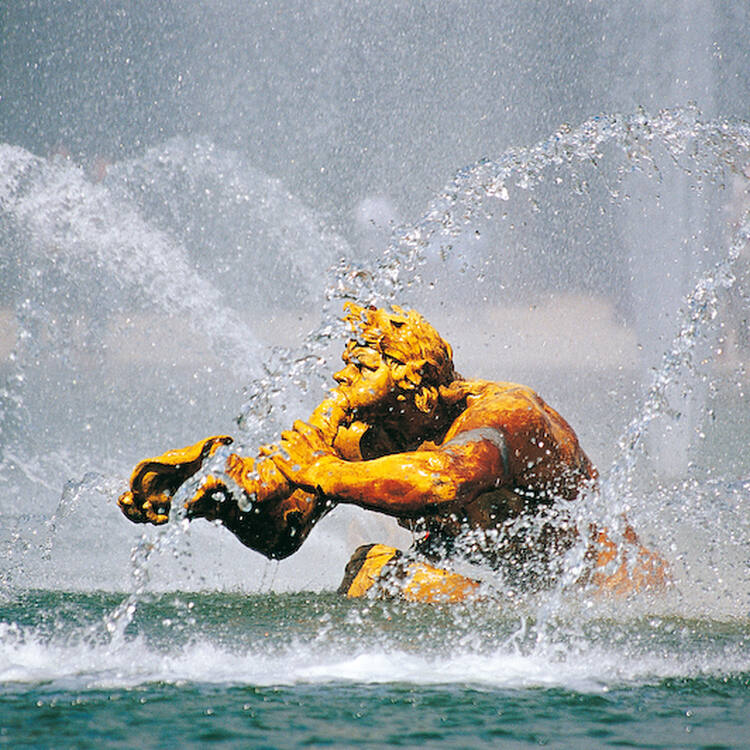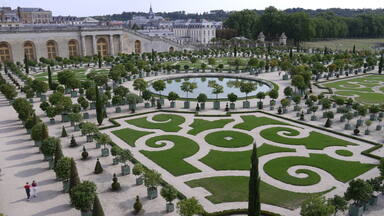Palace and Park of Versailles
Palace and Park of Versailles
The Palace of Versailles was the principal residence of the French kings from the time of Louis XIV to Louis XVI. Embellished by several generations of architects, sculptors, decorators and landscape architects, it provided Europe with a model of the ideal royal residence for over a century.
Description is available under license CC-BY-SA IGO 3.0
Palais et parc de Versailles
Lieu de résidence privilégié de la monarchie française de Louis XIV à Louis XVI, le château de Versailles, embelli par plusieurs générations d'architectes, de sculpteurs, d'ornemanistes et de paysagistes, a été pour l'Europe pendant plus d'un siècle le modèle de ce que devait être une résidence royale.
Description is available under license CC-BY-SA IGO 3.0
قصر وحديقة فيرساي
إنّ قصر فيرساي الذي يُعتبر المقرّ المفضّل للنظام الملكي الفرنسي من لويس الرابع عشر حتى لويس السادس عشر، والذي عملت على تزيينه وزخرفته أجيال من المهندسين والنحاتين والمزينين بالنقوش ورسامي الطبيعة، لطلما شكّل بالنسبة لأوروبا خلال أكثر من قرن النموذج لما يجب أن يكون عليه القصر الملكي.
source: UNESCO/CPE
Description is available under license CC-BY-SA IGO 3.0
凡尔赛宫及其园林
凡尔赛宫是路易十四至路易十六时期法国国王的居所。经过数代建筑师、雕刻家、装饰家、园林建筑师的不断改造润色,一个多世纪以来,凡尔赛宫一直是欧洲王室官邸的典范。
source: UNESCO/CPE
Description is available under license CC-BY-SA IGO 3.0
Дворец и парк в Версале
Версальский дворец был главной резиденцией королей Франции от Людовика XIV до Людовика XVI. Украшенный несколькими поколениями архитекторов, скульпторов, декораторов и садовников, он более столетия являлся образцом идеальной королевской резиденции для всей Европы.
source: UNESCO/CPE
Description is available under license CC-BY-SA IGO 3.0
Palacio y parque de Versalles
Lugar predilecto de residencia de la monarquía francesa entre los reinados de Luis XIV y Luis XVI, el palacio de Versalles, embellecido por sucesivas generaciones de arquitectos, escultores, decoradores y paisajistas, fue durante más de un siglo el modelo de palacio real por excelencia en toda Europa.
source: UNESCO/CPE
Description is available under license CC-BY-SA IGO 3.0
ヴェルサイユの宮殿と庭園
パリの南西約18kmにある、宮廷文化の全盛時代を象徴する宮殿と庭園。ルイ14世時代に始まり、ルイ15世、ルイ16世と王妃マリー・アントワネット、ナポレオンなどにより新築、改修が繰り返された。「鏡の間」は、室内装飾家シャルル・ル・ブランによる装飾芸術の最高傑作で、ルイ14世の栄光を讃えた天井の装飾画、ブロンズ製の柱頭などが特に知られている。578枚の鏡が光に反射して、装飾の豪華さをさらにひきたてている。source: NFUAJ
Paleis en park van Versailles
Het paleis van Versailles – de Fransen spreken van het kasteel van Versailles – was oorspronkelijk een jachtpaviljoen dat verbouwd werd tot kasteel en voor de koningen vanaf Lodewijk XIV tot Lodewijk XVI functioneerde als hoofdresidentie. Het is een van de grootste paleizen ter wereld en is verfraaid door meerdere generaties architecten, beeldhouwers, schilders en landschapsarchitecten. Gedurende meer dan een eeuw stond het model voor Europa als ideale koninklijke residentie. De grootste en bekendste zaal is de spiegelzaal die diende als ontvangstruimte en balzaal, beroemd vanwege de muurschilderingen en vele spiegels. Rondom het paleis ligt het prachtige park van Versailles.
Source: unesco.nl
Outstanding Universal Value
Brief description
Located in the Île-de-France region, south-west of Paris, privileged place both of residence and the exercise of power of the French monarchy from Louis XIV to Louis XVI, the Palace and Park of Versailles, built and embellished by several generations of architects, sculptors, painters, ornamentalists and landscape artists, represented for Europe for more than a century, the perfect model of a royal residence. The architectural planning and the majestic composition of the landscape form a close symbiosis, serving as a setting for the magnificence of the interior decorations of the apartments.
The inscribed property includes the zone enclosing the prestigious ensemble of the Palace, the Trianon châteaux and their gardens, as well as a narrow band of land offering the perspective from the extremity of the Grand Canal. It is the result of a century and a half of work commanded by the kings of France and entrusted to its greatest artists.
The strongest imprint has been left by Louis XIV, who started by enlarging the small brick and stone château built by his father, Louis XIII, in 1624. A first addition occurred after 1661 under the direction of Le Vau, in a still strongly italianite style. After 1678, Versailles was once again considerably enlarged and radically modified by Jules Hardouin-Mansart, who successfully introduced a sober, colossal, homogenous and majestic architecture, now inseparable from the memory of the Sun King. The famous Galerie des Glaces, between the Salon de la Guerre and that of the Paix, is the masterpiece of the Neo-classical and typically French style, called Louis XIV. The Orangerie and the Grand Trianon are also the work of Mansart, who was assisted by Robert de Cotte in the construction of the Royal Chapel.
The creations at Versailles during the 18th century are among the most perfect and most celebrated works of the Louis XV and Louis XVI styles: the Petit Trianon by Jacques-Ange Gabriel, the decoration of the appartments of Louis XV by Verbeckt and Rousseau, and the appartments and the Hameau of Marie-Antoinette by Mique.
The gardens that complete the Palace, developed during the construction process of the ensemble, were designed by Le Nôtre, creator of the typology of the French-style garden, an open system of axial pathways extending as far as the eye can see and punctuated with flowers and low hedges, flower beds, small streams, large lakes and fountains.
Criterion (i): The ensemble of the Palace and Park of Versailles constitutes a unique artistic realisation, by virtue not only of its size but also of its quality and originality.
Criterion (ii): Versailles exercised great influence throughout Europe from the end of the 17th century to the end of the 18th century. Wren incorporated reminiscences of Versailles into Hampton Court, Schlüter into Berlin, in designing the façades of the Palais Royal. “Little Versailles” have sprung up: Nymphenburg, Schleissheim, Karlsruhe, Würtzbourg, Postdam, Stockholm, etc. Le Nôtre’s gardens, designed by the architect himself, or by his imitators are innumerable: from Windsor to Cassel, to the Granja, Sweden, Denmark and Russia.
Criterion (vi): The absolute seat of power of the monarch, Versailles was the best formulated and best adapted crucible for French court life for a century and a half (Louis XIV perfectioned “etiquette”) and artistic creation in the domain of music, theatre and the decorative arts. Numerous scientific discoveries were presented there, encouraged by the kings, founders of royal academies. It was at Versailles that, on 6 October 1789, the people came to carry off Louis XVI and Marie-Antoinette, once again shifting the centre of power back to Paris.
Integrity
The Palace and Park of Versailles lost their function with the Revolution, but the ensemble was conserved by the State and transformed into a museum at the beginning of the 19th century. Although the furniture and the decorations were dispersed or partly destroyed, and the influence of the domain modified by assignments to different bodies, the integrity of Versailles must however be considered as good. The domain was endowed to a public body in 1996. Since then, the transfer of buildings and land has enabled the partial restitution of the coherence of the Palace and Park of Versailles: the most important being the Grand Commun, Grande Écurie (Stables) and the Mortemets, the Midi Wing and the Place d’Armes.
Authenticity
The Revolution and its consequences caused destruction and dispersion at Versailles, while the transformation of the Palace into a museum, in the 19th century, brought about new decorations and new spaces. The authenticity of Versailles is preserved through the policy undertaken, over many decades, of the reconstitution of interior spaces and furnishings.
Protection and management requirements
State-owned, the Palace and Park of Versailles are fully listed under Historic Monuments. Accordingly, they benefit from important conservation and restoration operations under the scientific and technical control of the State that ensures its funding. Since the creation of the public body, the work is programmed in the framework of the master plan. It concerns the restoration of the buildings and plans of the original sites. It also involves the updating of technical installations, in particular accessibility and fire safety regulations.
In the case of Versailles, the protection plan surrounding the historic monument was specially enlarged and adapted to serve as a buffer zone for the World Heritage property.
The “Plaine de Versailles” where the vestiges of the Allée de Villepreux are found, is a listed site under the Environment Code. From there, the Royal Star prolonged the great perspective of the Palace over five kilometres through the king’s hunting forest.
A management plan will be prepared in due course by the public body, in liaison with all the stakeholders, taking into account the different protection regimes that apply to the building, its surroundings and the listed site that borders it.
 View photos from OUR PLACE the World Heritage collection
View photos from OUR PLACE the World Heritage collection

